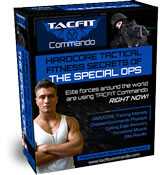Working With Pre-Existing Conditions
 Now there are many benefits of having a strong core. In last day’s post Flow Coach, Scott Sonnon gives a few tricks and tips in order to get more volume out of an exercise so that you can hit that high intensity workout.
Now there are many benefits of having a strong core. In last day’s post Flow Coach, Scott Sonnon gives a few tricks and tips in order to get more volume out of an exercise so that you can hit that high intensity workout.
Proper form and technique is something we have to keep in mind with all levels of exercise. TACFIT Commando programs are specifically designed with this in mind guiding you through pain free movements. Today were going to discuss how to strengthen the most common injury most people have.
******************
Craig Ballantyne: All right, Curtis in Las Vegas and Mark from Chicago ask a good question. So people who have shoulder injuries that do exercise like the tripod overhead and the arm swing, how are those done properly to avoid shoulder injury or do they need to be modified or avoided if somebody has preexisting shoulder injuries?
Scott Sonnon: Okay. That’s a great question. There’s obviously a surgical limit to certain exercises. Let’s say you’ve had a disc fused in your neck, there will be movements that you will not be able to do. In the tripod overhead, I’m assuming that you’re talking about the Israeli Special Forces TACFIT challenge. I used with the IDS and their secret service. Now, this is a Commando level movement.
The basic version of the tripod overhead extension is where your feet and your hands are flat, and you’re in a crab position with your legs together. The basic motion is being able to press your hips up until you have full hip extension and your head is in alignment with your spine so you look like a table belly up.
If you CAN’T do that without pain or pins and needles in your shoulder or running down your radial nerve then you’re at the surgical limit, and you should not do the exercise, because that’s the screening test for whether you can work up to the overhead extension that you see in the Israeli Special Forces challenge.
If you CAN do this without pain, but you can’t perform the table position with one arm your legs separated then you should stay at the full table position. You’re still getting 100% of the fitness and medical benefits even though you’re doing it at a lower level.
I know it’s really cool to do complex movements, I get it, and I’m a fan, but the point isn’t to do the higher level movements. The point is for there to be an option to increase the complexity so that the nervous system can create more fingers in your brain. It increases the plasticity this is the technical term used in neuroscience.
Your brain becomes more complex, which is the same neurological phenomenon that happens when you experience A SECOND WIND. It happens when you are in a circular respiratory distress, you’re breathing really heavy, you’re panting, you have cold sweats, and you have little phantom pains, all of these things.
People think that this is the limit of their conditioning, that’s just a first gear. If you’re able to step through that safely, I’m talking without pain or pins and needles, and you step through it. The brain makes it easier for the rest of the body to continue the rest of the activity.
So, if you start with a primary exercise, in this case, the table, and you’re able to do the 20/10 program. With a lower sophistication, you’re still going to be able to hit that second gear getting that second wind and that’s really where it starts to happen with the fat burn and the muscle gain, because the brain forces a change to happen in the body. As long as you don’t have pain and pins and needles.
So you first have to screen the movement, in this case with the shoulder, if you can do the table without pins and needles and without any local sharp pain in the shoulders then do that movement. Soon as you can do that movement without feeling pain than the next time you do it separate your legs and lift one arm off the ground pointing it at the sky.
The next step is to take the arm overhead to get the full spinal arch. The HEALTH OF THE SPINE is directly related to backward flexion. If you can’t flex your spine backward it’s an unhealthy spine basically.
So, the goal is first to get it into normal alignment then slowly encourage backward flexion. Each one of the motor progressions is a screening for the next subsequent one. If you have pain choke down in sophistication until you can do it without pain.
Remember that you have to do the mobility exercises to prepare for it. Then the compensation exercises afterwards to unload the tension so that you don’t diminish the movement. That’s the other end of the spectrum.
The cool down is absolutely critical to your ability to do the next workout. Remember bigger is not better, faster is not better, stronger is not better, only better is better.
Craig Ballantyne: Awesome. That’s it for today’s post. Join us tomorrow where Scott Sonnon explains how to properly perform another compound exercise that uses muscles in the chest, shoulders, triceps, back, abs and even the legs. Click here to read part 9.